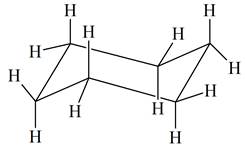
Concept explainers
(a)
Interpretation:
The three distinct chair conformations for cyclohexylcyclohexane is to be drawn.
Concept introduction:
Chair conformations have three sets of parallel lines drawn together at a time. Equatorial bonds are drawn parallel to the line representing the

(b)
Interpretation:
The most stable conformation of cyclohexylcyclohexane is to be determined.
Concept introduction:
When each substituent is attached to a cyclohexane ring in an equatorial position, the chair conformation is most stable than in an axial position. In the monosubstituted cyclohexane, the substituents that are attached to equatorial positions of each other are most stable. If two or more substituents are attached to cyclohexane, then the conformation in which maximum substituents are in equatorial position is more stable than the axial position.
Want to see the full answer?
Check out a sample textbook solution
Chapter 4 Solutions
EBK ORGANIC CHEMISTRY: PRINCIPLES AND M
- Can I please get help with this?arrow_forwardUse the Henderson-Hasselbalch equation to calculate pH of a buffer containing 0.050M benzoic acidand 0.150M sodium benzoate. The Ka of benzoic acid is 6.5 x 10-5arrow_forwardA. Draw the structure of each of the following alcohols. Then draw and name the product you would expect to produce by the oxidation of each. a. 4-Methyl-2-heptanol b. 3,4-Dimethyl-1-pentanol c. 4-Ethyl-2-heptanol d. 5,7-Dichloro-3-heptanolarrow_forward
- What is the pH of a 1.0 L buffer made with 0.300 mol of HF (Ka = 6.8 × 10⁻⁴) and 0.200 mol of NaF to which 0.160 mol of NaOH were added?arrow_forwardCan I please get help with this.arrow_forwardDetermine if the following salt is neutral, acidic or basic. If acidic or basic, write the appropriate equilibrium equation for the acid or base that exists when the salt is dissolved in aqueous solution. If neutral, simply write only NR. Be sure to include the proper phases for all species within the reaction. N₂H₅ClO₄arrow_forward
 Organic ChemistryChemistryISBN:9781305580350Author:William H. Brown, Brent L. Iverson, Eric Anslyn, Christopher S. FootePublisher:Cengage Learning
Organic ChemistryChemistryISBN:9781305580350Author:William H. Brown, Brent L. Iverson, Eric Anslyn, Christopher S. FootePublisher:Cengage Learning
